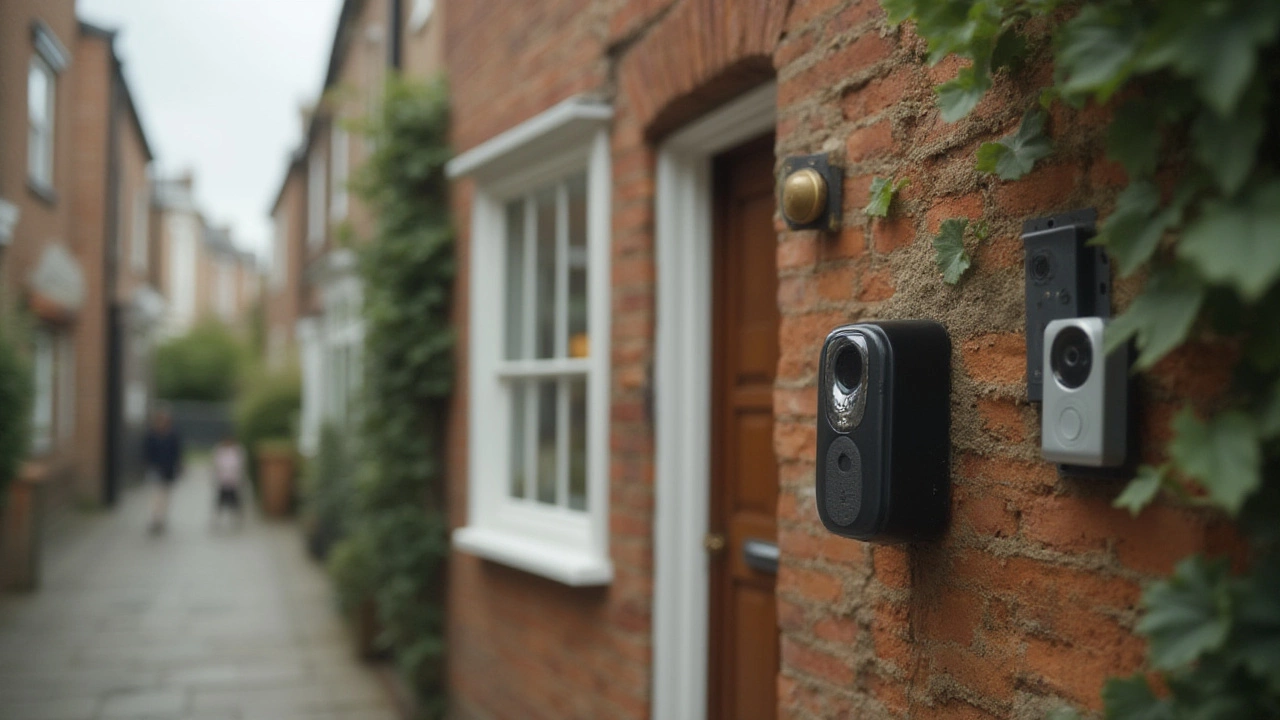Ever stood outside someone’s door, jabbing at the doorbell, only to wonder if the thing even works? Doorbells are way more interesting than they first seem, and way more important too. Did you know that the first electric doorbell dates all the way back to the early 1800s? Back then, inventors were just trying to solve the age-old problem of how to make it clear someone is at the door without all the yelling. Fast forward to today, and there’s a whole buffet of doorbell options: wired classics, slick wireless units, and high-tech smart versions that can ping your phone and even record video. If you’re thinking about a change or you keep fiddling with a finicky old ringer, you’re not alone. Picking the right kind comes down to more than just taste—it’s about function, style, safety, and a touch of tech magic that can actually make your life easier.
Wired Doorbells: The Tried and True Classic
Picture those old houses with the sturdy metal chimes echoing down the halls. That’s the wired doorbell—a real staple in homes for over a century. Wired doorbells have two main parts: a button outside and a chime box inside, connected by low-voltage wires. When you press the button, it completes an electrical circuit that rings the chime. These setups are surprisingly simple, and the technology really hasn’t changed much since those early days. One cool thing about wired doorbells is their reliability. Because they’re hardwired straight into your home’s electrical system or a separate transformer, they rarely run into battery problems. Some wired systems last decades without a hiccup—ask anyone who’s lived in an old colonial or craftsman-style home.
Another underrated perk: wired doorbells never lose their signal or stop working because of a dead battery. They’re also much less likely to suffer from interference, which happens a lot with cheaper wireless models. Plus, if you like the idea of a traditional chime, those bar-style mechanical chimes you hear in classic homes? They only work with wired systems. From a security angle, hardwiring means there’s less chance of someone tampering with your doorbell undetected. Even if the power goes out, many transformers can handle short outages, and you can easily add a backup battery to the circuit for kicks.
On the downside, installation can be a real project, especially in houses that didn’t already run the necessary wiring. Cutting tiny holes in walls, crawling around in attics, and fiddling with electrical boxes isn’t everyone’s idea of a good time. If you’re handy, you can do it, but calling in an electrician isn’t uncommon. Still, once it’s in, you’ll likely not have to fuss with it again for years. If you crave reliability and have a knack for DIY or don’t mind making a couple of phone calls to pros, wired doorbells are still tough to beat. No batteries, no worry about Wi-Fi coverage, just that familiar ding-dong every time someone visits.
Wireless Doorbells: Flexibility Without the Fuss
If running wires through your home sounds like a nightmare, wireless doorbells are the no-drama alternative. Wireless doorbells became popular in the late 20th century as radio technology improved. The basic setup is super simple: you’ve got a button powered by a small battery and a chime box that plugs into any wall outlet. Press the button, and the transmitter sends a short radio signal to the receiver, which plays a tune. With this system, you can pretty much put a doorbell anywhere, no drilling or crawling in scary basements needed. That’s especially handy for renters, or anyone wanting an easy upgrade that won’t void a lease or require landlord permission.
Wireless doorbells score points for convenience. Moving the chime box is as easy as unplugging it and trying another outlet. Some receivers let you pair multiple buttons to one chime, which works wonders for people with more than one entrance. If you want, you can set up individual tones for each door, so you’ll know exactly which entry someone’s using. Modern wireless systems operate on secure frequencies to prevent random radio interference. But cheaper ones can still get tripped up by other wireless devices or thick walls—that’s something worth watching out for if you live in a busy apartment building or an old house with tons of brick and stone.
Battery changes are a fact of life here, but many transmitters use standard button batteries that last a year or more. You can even find models with solar-powered buttons that barely need maintenance. Affordable models cost less than a big pizza, and you can pick them up at hardware stores, online, or even some big grocery chains. As useful as they are, wireless doorbells do have limits: range is one. Most max out between 100 and 300 feet, though newer models can push that quite a bit further. Also, while some pricier versions come with built-in flashing lights (great if you’re hard of hearing), most are plain-Jane sound only. But if you want fast installation, minimal hassle, and the ability to move things around as you see fit, wireless doorbells fit the bill.

Smart Doorbells: The Connected Revolution
Here’s where things get futuristic. Smart doorbells combine the features of a regular doorbell with Wi-Fi, cameras, microphones, and sometimes even facial recognition. The first really popular smart doorbell, the Ring Video Doorbell, hit the market just over a decade ago, and these things have exploded in popularity since. Installation is a mix—it can be as easy as sticking a battery-powered unit on the wall or as involved as hardwiring a fancier model into your old doorbell circuit. Either way, most smart doorbells connect to your phone, smart speaker, or home assistant system, giving you real-time alerts when someone presses the button or even when they just walk by thanks to motion sensors.
These smart wonders don’t just alert you—they show you. Most models stream HD video to your phone in seconds, turning the peephole into a full-blown security tool. Want to see who’s dropping off that package or check on the kids getting home? Just open the app. Some models offer two-way audio, letting you chat with anyone at your door—super handy for telling delivery workers to leave your package behind the planter or deterring sketchy visitors. Most smart doorbells also let you review video history, so if you miss a real-time alert, you can still see who stopped by. Privacy buffs in 2025 will be glad to know high-end models now come with encrypted storage, adjustable motion zones, and even privacy screens that blur out the street in front of your house.
But smart doesn’t mean perfect. You’ll need a solid Wi-Fi signal by the door, which isn’t always easy with some older homes or thick exterior walls. Battery-powered versions need a recharge every few weeks or months, depending on settings and traffic, but hardwired models sip power from your existing wiring. Most of the coolest features—like cloud video storage or AI detection—come with a small subscription fee. Smart doorbells are also a favorite for package theft prevention, since the mere presence of a camera can scare off would-be porch pirates. For anyone into home automation, some models integrate with smart locks, lights, or even voice assistants, letting you open the door with a command or set lights to turn on when someone steps on the porch. Setup is usually app-guided and takes under an hour if your wiring is friendly. Smart doorbells are a step beyond convenience—they really do boost security and make daily life easier in ways you might not expect.
Choosing the Right Doorbell for Your Space
This isn’t a one-size-fits-all kind of thing. Your house’s age, wiring setup, Wi-Fi coverage, and your own tech comfort level make a huge difference. If you live in a modern build with easy-access wiring, and you want that classic chime, wired doorbells check a lot of boxes. If you’re renting or just want something fast and zero-fuss, wireless doorbells are probably the best match. Smart doorbells? That’s for those who love seeing everything on their phone and are willing to put in a bit more time (and maybe budget for a storage subscription). Pro tip: if you pick a smart model, spend ten minutes mapping your Wi-Fi coverage near the door to avoid surprise dead spots. If you hate changing batteries, look for hardwired versions that work with existing wiring. If you’re in a place that gets a lot of rain, double-check the waterproof rating—most modern doorbells can handle a storm, but it’s still worth confirming.
Noise level in your house matters too. Do you need a chime you can actually hear over the TV or the kids? Bigger homes or busy spaces might need additional plug-in chimes or models that send phone notifications. Think about guests or delivery drivers—do they find your current doorbell quickly, or is it a game of hide and seek? If you travel a lot, smart doorbells give you peace of mind by letting you peek at your doorway from pretty much anywhere in the world. And if accessibility is important, plenty of wireless and smart models now come with light signals and extra-loud options because everyone deserves to know when someone’s at the door.

Tips and Fun Facts for Doorbell Owners
Some doorbells last so long they outlive the houses they’re attached to. There are places in Europe with chimes pushing a hundred years old! Newer doorbells can be personalized—choose your own ring, from classical notes to goofy pop songs or seasonal jingles. For parents, some smart models let you set ‘quiet hours’ so you’re not hit with a chorus of chimes during baby’s nap. Got a beloved pet? Wireless doorbells with big buttons can be trained as doggy doorbells, so Fido can let you know when it’s potty time. Maintenance is simple for most types: just clean the button and check for corrosion on older wired systems, or swap a battery every now and then in wireless setups.
Here’s another tip: if you get constant deliveries or have kids who lose keys, combining a smart doorbell with a video feed and paired smart lock can really simplify life. Be careful when drilling into exterior bricks or wood—many doorbells now include adhesive mounts for those tricky surfaces. And if privacy is a concern, modern smart models now include customizable motion zones, night vision, and encrypted video uploads to keep your porch footage safe from snooping.
People use doorbells for more than front-door hellos. They’re handy for home offices, side gates, workshops, even barns. Try putting a wireless chime in a basement or detached garage, so you never miss a visitor. For folks with hearing loss, look for wireless models with strong vibration alerts or extra-bright flashes. If you move homes often, wireless and portable smart models easily come with you—just pack the receiver and stick the button up somewhere new. And if you like your gadgets to blend in, tons of modern doorbells now come in different shapes, colors, and finishes, from sleek all-blacks to faux-brass retro looks.
Whatever matches your vibe, doorbells are more than just a button—they’re your home’s first hello, quiet warning system, and secret bit of convenience. Whether you go classic with hardwiring, modern with radio waves, or embrace all-out smart tech, picking the right one can add not just function, but a bit of fun (and peace of mind) to your daily routine. Don’t be afraid to experiment or swap up your setup if your needs change. The right doorbell is out there—sometimes, it just takes a good ring to find it.

